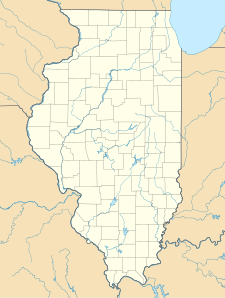Cave-in-Rock State Park
| Cave-In-Rock State Park | |
|---|---|
|
IUCN category III (natural monument or feature)
|
|
 |
|
|
Map of the U.S. state of Illinois showing the location of Cave-In-Rock State Park
|
|
| Location | Hardin County, Illinois, U.S. |
| Nearest city | Elizabethtown, Illinois |
| Coordinates | 37°28′07″N 88°09′21″W / 37.46861°N 88.15583°WCoordinates: 37°28′07″N 88°09′21″W / 37.46861°N 88.15583°W |
| Area | 204 acres (83 ha) |
| Established | 1929 |
| Governing body | |
|
Cave-In-Rock
|
|
| Location | 0.5 mi N of the town of Cave-In-Rock, Cave-In-Rock, Illinois |
| Area | less than one acre |
| Built | 1861 |
| Architectural style | Other, natural cave |
| MPS | Caught in the Middle: The Civil War on the Lower Ohio River MPS |
| NRHP Reference # | 98000984 |
| Added to NRHP | August 6, 1998 |
Illinois Department of Natural Resources
Cave-In-Rock State Park is an Illinois state park, on 240 acres, in the town of Cave-in-Rock, Hardin County, Illinois in the United States. The state park contains the historic Cave-in-Rock, a landmark of the Ohio River. It is maintained by the Illinois Department of Natural Resources (IDNR).
Cave-in-Rock was known and used for thousands of years by the Native Americans. The first European to discover the Cave was M. de Lery of France, who in 1729 mapped and named it "caverne dans Le Roc" (cf. supra). This name, translated directly into English, is the name the cave bears to this day.Other names for the cave include Rock-In-Cave, Rocking Cave, Rock-and-Cave, House of Nature, The Cave, Big Cave, and Murrell's Cave. The cave has been the main feature of Illinois' Cave-in-Rock State Park since 1929.
During the 1790s and the first three decades of the 19th century, Cave-in-Rock reached the height of its notoriety. Flatboats carrying farm produce from Kentucky, Ohio, and southern Indiana began to float down the Ohio River towards the marketplace in New Orleans. As a known Ohio River landmark, the cave was a landmark of this dangerous journey. From approximately 1797 until 1799, the cave was a hideout for a notorious gang of bandits, headed by Samuel Mason, that preyed upon the lawless river commerce. The outlaws Frank and Jesse James of the notorious James Gang also hid out in the cave, according to local lore, leaving their marks in the cave.
...
Wikipedia

